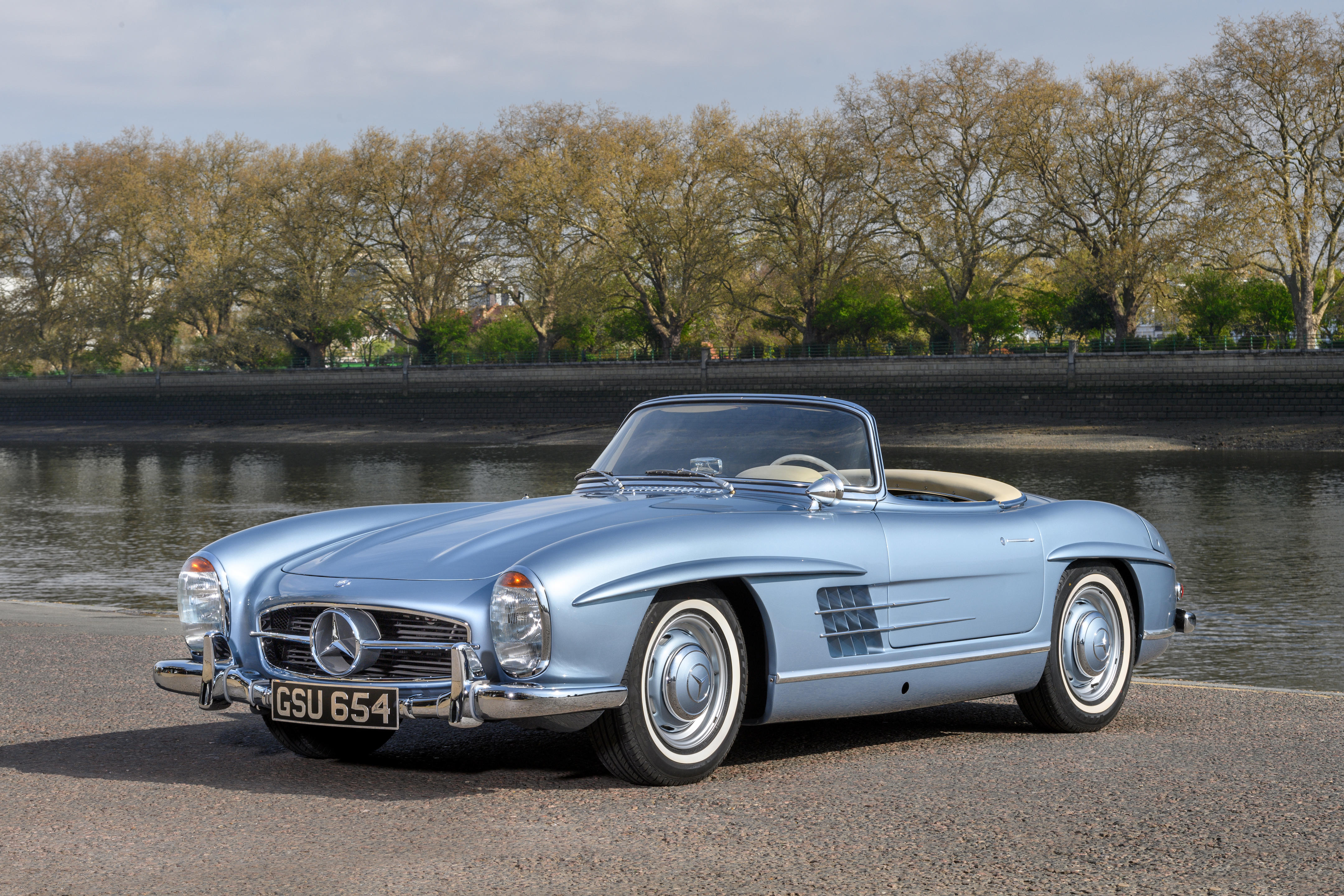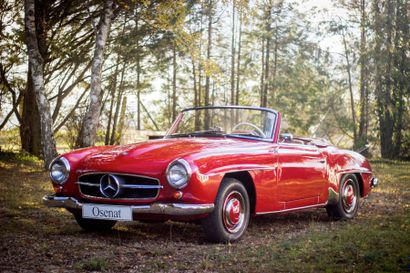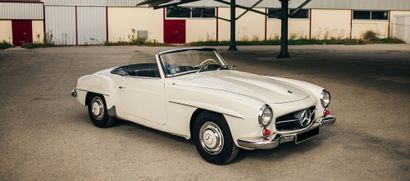1959 Mercedes-Benz 300 SL Roadster Chassis no. 198042100002388 •One of 1,858 built •Matching numbers •Present ownership since 1988 •Original condition and interior •Registered in Germany Fußnoten Created to spearhead Mercedes-Benz's return to competition in the post-war era, the 300 SL debuted in the 1952 Mille Miglia, finishing 2nd and 4th overall. Wins in the Carrera Pan-Americana and at Le Mans followed, and the 300 SL was on its way to becoming part of motor sporting legend. Max Hoffman, the Mercedes-Benz importer for North America, believed there would be a market for a road-going version and managed to convince the factory that such a car would be a success. The first racers were open-topped but before the '52 season's end the distinctive 'Gullwing' doored Coupé had appeared. Unusually high sills were a feature of the multi-tubular spaceframe chassis, and while access was not a problem of the open car, the adoption of coupé bodywork required innovative thinking - hence the Gullwing doors. Launched in 1954, the production 300 SL retained the spaceframe chassis of the racer and was powered by a 2,996cc, overhead-camshaft, inline six canted at 45 degrees to achieve a lower, more aerodynamic bonnet line. Using innovative direct fuel injection, this state-of-the-art power unit produced 215bhp at 5,800rpm. A four-speed gearbox transmitted power to the hypoid bevel rear axle. Suspension was independent all round by wishbones and coil springs at the front, with swing axles and coil springs at the rear. Tested by the highly respected American magazine Road & Track in 1955, the 300 SL accelerated from 0-60mph in 7.4 seconds, going on to achieve a top speed of 140mph: outstanding figures for its day. It was, arguably, the world's first supercar. Half expecting the long-awaited 300 SL to provide an anti-climax, R&T were delighted to find the new car, "far beyond our wildest expectations. In fact, we can state unequivocally that in our opinion the 300 SL coupé is the ultimate in an all-round sportscar. It combines more desirable features in one streamlined package than we ever imagined or hoped would be possible. Performance? It accelerates from a dead start to 100mph in just over 17 seconds. Dual purpose? A production model 300 SL can make a very acceptable showing in any type of sportscar competition. Yet the car is extremely tractable and easy to drive in traffic. Comfort? The fully enclosed 300 SL is the most comfortable (and safe) high-speed 'cross-country' car built today." Its racing parentage notwithstanding, the 300 SL was and remains a thoroughly practical automobile, as civilised in city driving as it is exhilarating on the highway. Clearly the 300 SL Coupé would be a hard act to follow yet the Roadster version, introduced just three years later, succeeded in bettering its closed cousin's already exemplary road manners. Built with conventional doors, the 300 SL Roadster was first exhibited at the Geneva Salon in May 1957 and was an immediate hit with the 1950s 'Jet Set' of royalty, actors, and socialites. The production of an open 300 SL involved altering the cockpit area, where the spaceframe was redesigned to permit lower sills for improved access. At the same time the rear suspension was changed to incorporate low-pivot swing axles. Disc brakes were standardised from March 1961, while towards the end of production a small batch of Roadsters was completed with an aluminium cylinder block. The Roadster's neutral steering characteristics received fulsome praise from Road & Track in its 1958 road test. "With the low-pivot rear suspension and more adhesive tyres, the car handles beautifully under all conditions. This is a tremendous improvement over the hardtop models, which had a tendency to oversteer rather violently if pressed too hard." A 0-60mph time of 7.0 seconds and a top speed of 130mph were recorded, making the 300 SL Roadster one of the fastest convertibles of its time. R&T concluded: "There is no doubt that the 3
1959 Mercedes-Benz 300 SL Roadster Chassis no. 198042100002388 •One of 1,858 built •Matching numbers •Present ownership since 1988 •Original condition and interior •Registered in Germany Fußnoten Created to spearhead Mercedes-Benz's return to competition in the post-war era, the 300 SL debuted in the 1952 Mille Miglia, finishing 2nd and 4th overall. Wins in the Carrera Pan-Americana and at Le Mans followed, and the 300 SL was on its way to becoming part of motor sporting legend. Max Hoffman, the Mercedes-Benz importer for North America, believed there would be a market for a road-going version and managed to convince the factory that such a car would be a success. The first racers were open-topped but before the '52 season's end the distinctive 'Gullwing' doored Coupé had appeared. Unusually high sills were a feature of the multi-tubular spaceframe chassis, and while access was not a problem of the open car, the adoption of coupé bodywork required innovative thinking - hence the Gullwing doors. Launched in 1954, the production 300 SL retained the spaceframe chassis of the racer and was powered by a 2,996cc, overhead-camshaft, inline six canted at 45 degrees to achieve a lower, more aerodynamic bonnet line. Using innovative direct fuel injection, this state-of-the-art power unit produced 215bhp at 5,800rpm. A four-speed gearbox transmitted power to the hypoid bevel rear axle. Suspension was independent all round by wishbones and coil springs at the front, with swing axles and coil springs at the rear. Tested by the highly respected American magazine Road & Track in 1955, the 300 SL accelerated from 0-60mph in 7.4 seconds, going on to achieve a top speed of 140mph: outstanding figures for its day. It was, arguably, the world's first supercar. Half expecting the long-awaited 300 SL to provide an anti-climax, R&T were delighted to find the new car, "far beyond our wildest expectations. In fact, we can state unequivocally that in our opinion the 300 SL coupé is the ultimate in an all-round sportscar. It combines more desirable features in one streamlined package than we ever imagined or hoped would be possible. Performance? It accelerates from a dead start to 100mph in just over 17 seconds. Dual purpose? A production model 300 SL can make a very acceptable showing in any type of sportscar competition. Yet the car is extremely tractable and easy to drive in traffic. Comfort? The fully enclosed 300 SL is the most comfortable (and safe) high-speed 'cross-country' car built today." Its racing parentage notwithstanding, the 300 SL was and remains a thoroughly practical automobile, as civilised in city driving as it is exhilarating on the highway. Clearly the 300 SL Coupé would be a hard act to follow yet the Roadster version, introduced just three years later, succeeded in bettering its closed cousin's already exemplary road manners. Built with conventional doors, the 300 SL Roadster was first exhibited at the Geneva Salon in May 1957 and was an immediate hit with the 1950s 'Jet Set' of royalty, actors, and socialites. The production of an open 300 SL involved altering the cockpit area, where the spaceframe was redesigned to permit lower sills for improved access. At the same time the rear suspension was changed to incorporate low-pivot swing axles. Disc brakes were standardised from March 1961, while towards the end of production a small batch of Roadsters was completed with an aluminium cylinder block. The Roadster's neutral steering characteristics received fulsome praise from Road & Track in its 1958 road test. "With the low-pivot rear suspension and more adhesive tyres, the car handles beautifully under all conditions. This is a tremendous improvement over the hardtop models, which had a tendency to oversteer rather violently if pressed too hard." A 0-60mph time of 7.0 seconds and a top speed of 130mph were recorded, making the 300 SL Roadster one of the fastest convertibles of its time. R&T concluded: "There is no doubt that the 3















Testen Sie LotSearch und seine Premium-Features 7 Tage - ohne Kosten!
Lassen Sie sich automatisch über neue Objekte in kommenden Auktionen benachrichtigen.
Suchauftrag anlegen